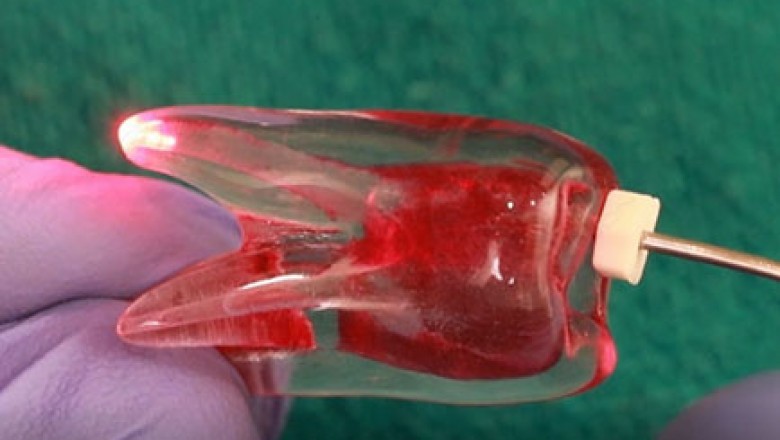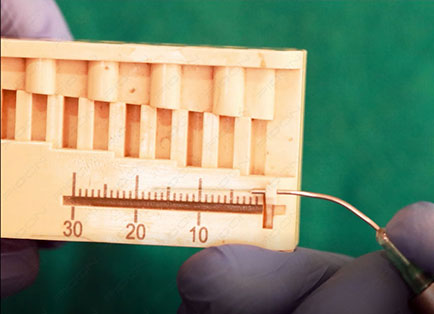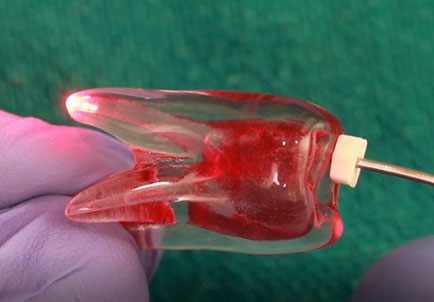ROOT CANAL DISINFECTION IN PERMANENT TOOTH USING LASER DURING ROOT CANAL PROCEDURE/ENDODONTIC TREATM
views

ROOT CANAL DISINFECTION IN PERMANENT TOOTH USING LASER DURING ROOT CANAL PROCEDURE/ENDODONTIC TREATM
Introduction- The main goal of endodontic treatment is the effective cleaning of the root-canal system and preventing the reinfection. Traditional endodontic techniques use mechanical instruments and chemical irrigation to shape, clean and completely decontaminate the endodontic system. The complexity of the root-canal system is very well known with added fact that most of the NiTi (Nickel-Titanium) instruments work on the center body of canal leaving behind fins, isthmus, cul-de-sacs all untouched. These left out spaces harbour tissue debris, bacteria and their by-products and this insufficient root canal disinfection is the main reason for endodontic failure. LASER helps to achieve this impossible task of disinfection of root canal system as a whole including the lateral and accessory canals. As back dated, Laser technology was introduced to endodontics with the goal of improving the results obtained with traditional procedures through the use of light energy by increasing cleaning ability and improving the decontamination of the endodontic system.
Rationale for the use of Laser - Irrigation is an essential part of root canal therapy because it allows for cleaning and bacterial reduction beyond what can be achieved by root canal instrumentation alone. However, because of high surface tension, chemical reagents penetrates only upto 130 µm into dentinal tubules, while bacteria can colonize the dentinal tubules deeply up to the periodontal surface (1100 µm from the canal lumen). Whereas, agitation of the irrigants has shown to enhance the reach into the dentinal tubules upto 800µm. When we talk about Laser light, it has shown the penetration upto a depth of 1000µm and even more into the dentinal tubules. Literature shows that If Laser and the agitation of Chemical Irrigant is combined together then they exert a synergistic endodontic disinfection, much superior than the individual effect respectively.
Prerequisite for use of LASER in Permanent Tooth -
Root Canal Preparation – The minimum canal preparation for a 200µm laser tip to reach upto the apical area corresponds to ISO file size 30.
Wet canals – Any chemical irrigants can be used like sodium hypochlorite, EDTA or both one after the other. Dry canals are a complete contraindication while using laser.
Working length - It is measured 1mm short of actual working length. E.g. If the working length of a canal is 19mm. So 19-1= 18 mm. This 18mm will be the length up to which the laser tip will go inside the canal.
Settings/parameters for laser root canal disinfection – The laser we have used is S1 Pioon Laser at 980nm wavelength and a 200µm non initiated tip is used at 2 Watt and Continuous Mode
Steps for Root Canal Disinfection - Under rubber dam isolation all the steps till chemomechanical preparation (CMP) remains the same as Laser disinfection is the final step before the obturation.
First - Irrigation- Wet the canals first with chemical reagent
Second – Use of Laser - Motion or Technique of Use of Laser is as under -
- Withdrawal of the tip from the canal is done at the rate of 2mm/second
- Disinfection starts from apex to canal orifice
- Move the tip in circumferential manner without touching the walls of canal
- Not more than 3 pass per canal should be done
- Total time not exceeding 30sec per canal
Third – Wait and Irrigate – Wait for 10 secs between each pass and follow it by replenishing the canal with fresh irrigant
Fourth – Repeat the process – A Maximum of 3 pass per canal can be done in a sitting.
Conclusion - Given the complex root canal anatomy and the limited ability of chemical irrigants to three-dimensionally clean and disinfect the entire endodontic space, the lasers has seen to adjunctively enhance the effectiveness of endodontic treatment, endodontic retreatment and prevent any further endodontic reinfection
References – 1) Giovanni Oliv. Laser Use in Endodontics: Evolution from Direct Laser Irradiation to Laser-Activated Irrigation. Journal of Laser Dentistry. 2013: 21(22); 58-71. 2) Giovanni Olivi, Rolando Crippa, Giuseppe Iaria, Vasilios Kaitsas, Enrico DiVito and Stefano Benedicenti, Laser in endodontics (Part I). Roots: 2011:1; 6-9.

Fig 1 – Measuring the Laser Tip before the disinfection procedure

Fig 2 – Laser Tip Placement in the apical area during Root Canal Disinfection Using Laser in a Permanent Tooth












